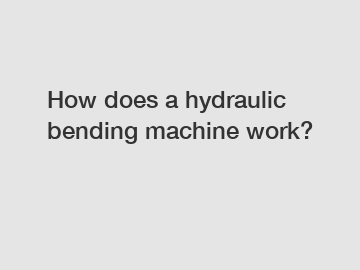How does a hydraulic bending machine work?
Hydraulic Bending Machine: A Closer Look at Its Mechanism.
Hydraulic bending machines are essential tools in various industries, including manufacturing, automotive, and construction. They are used to bend metal sheets or plates into different shapes to create a wide range of products. Understanding how a hydraulic bending machine works can provide insights into its efficiency and versatility.
Working Principle of a Hydraulic Bending Machine.

A hydraulic bending machine utilizes hydraulic pressure to bend metal sheets or plates. The machine consists of a hydraulic system, a bending tool, and a control panel. The hydraulic system comprises a hydraulic pump, hydraulic cylinders, valves, hoses, and fittings. When the machine is operational, the hydraulic pump generates high-pressure hydraulic fluid, which is then transferred to the hydraulic cylinders through hoses.
The hydraulic cylinders are responsible for generating the force required to bend the metal sheet. By controlling the flow of hydraulic fluid using valves, the operator can adjust the pressure exerted by the cylinders on the metal sheet. This precise control ensures accurate and consistent bending results. The bending tool, typically a die and a punch, applies the force from the hydraulic cylinders onto the metal sheet to bend it to the desired angle.
Key Components of a Hydraulic Bending Machine.
1. Hydraulic Pump: The hydraulic pump generates the necessary pressure to operate the hydraulic system. It converts mechanical energy into hydraulic energy by displacing fluid from a reservoir and sending it through the system.
2. Hydraulic Cylinders: These cylinders contain a piston that moves back and forth when hydraulic fluid is introduced into them. The movement of the piston creates the force needed to bend the metal sheet.
3. Valves: Valves control the flow of hydraulic fluid in the system. By adjusting the valves, the operator can regulate the pressure exerted by the hydraulic cylinders, allowing for precise bending operations.
4. Bending Tool: The bending tool, which consists of a die and a punch, applies the force from the hydraulic cylinders onto the metal sheet. The die supports the metal sheet, while the punch presses against it to create the bend.
Operation of a Hydraulic Bending Machine.
To operate a hydraulic bending machine, the operator first selects the appropriate die and punch for the desired bend angle and radius. The metal sheet is then placed between the die and punch, and the hydraulic system is activated. By adjusting the valves, the operator controls the pressure exerted by the hydraulic cylinders on the metal sheet, gradually bending it to the desired angle.
Once the bending process is complete, the hydraulic system is deactivated, and the metal sheet is removed from the machine. The precision and repeatability of hydraulic bending machines make them ideal for mass production and high-precision bending tasks.
In conclusion, hydraulic bending machines are versatile tools that play a crucial role in various industries. By understanding how these machines work and their key components, manufacturers can make informed decisions about incorporating them into their production processes. The efficiency and precision offered by hydraulic bending machines make them indispensable in modern manufacturing operations.
Contact us to learn more about hydraulic bending machines and how they can benefit your business.
Are you interested in learning more about Manual Wire Straighteners, Rebar Straightening Machine Suppliers, High Quality Metal Wire Straightening and Cutting Machine? Contact us today to secure an expert consultation!


